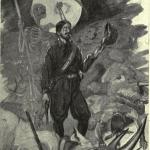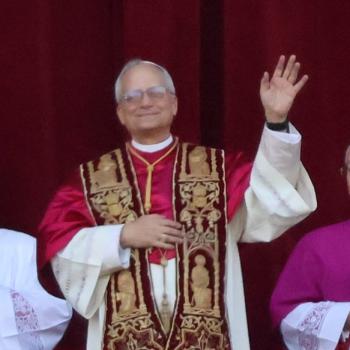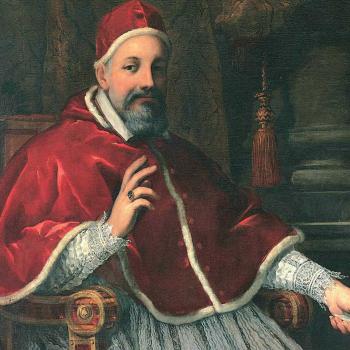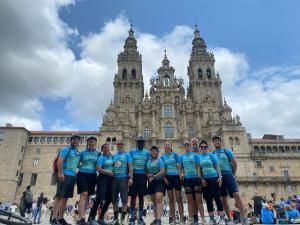 My husband Tommy just turned fifty. For the last 5 years he has planned to celebrate this milestone by going with a group of friends as “bicigrinos” or bicycle pilgrims along the Camino Primitivo in Northern Spain. It took a great deal of organization and for a couple years during the pandemic we weren’t sure the pilgrimage was going to happen. But on July 8 we completed the 308 km with a total of 11 people, including 3 teenagers. We came from the USA and Australia, and except for Tommy, we were woefully unprepared for the elevations we needed to bike each day. Most of us were on e-bikes, which helped, but it was still a daunting trip. The regions of Asturias and Galicia were stunning places to cycle through, and we ended in Santiago de Compestela with the inevitable emotions.
My husband Tommy just turned fifty. For the last 5 years he has planned to celebrate this milestone by going with a group of friends as “bicigrinos” or bicycle pilgrims along the Camino Primitivo in Northern Spain. It took a great deal of organization and for a couple years during the pandemic we weren’t sure the pilgrimage was going to happen. But on July 8 we completed the 308 km with a total of 11 people, including 3 teenagers. We came from the USA and Australia, and except for Tommy, we were woefully unprepared for the elevations we needed to bike each day. Most of us were on e-bikes, which helped, but it was still a daunting trip. The regions of Asturias and Galicia were stunning places to cycle through, and we ended in Santiago de Compestela with the inevitable emotions.
What was a good Protestant girl like me doing on the third most significant of the great medieval Catholic pilgrimage routes? Not to mention attending the pilgrim mass and getting my “Compostela” stamped as proof of my virtuous trip? At various points along the way, I asked myself these questions and was aware that while I felt very committed to spiritual travel, my trip was possibly not the kind of trip that the Camino was developed for.
The Camino refers to a complex networks of routes that Western (and a few Eastern) Christians took, starting in the 9th century, to visit the tomb of the Apostle James (Santiago in Spanish) who is credited with bringing Christianity to Spain. The king of Asturias, an 8th and 9th century Christian kingdom, was the first to officially travel to the tomb when it was discovered and identified in the early 800s, and it is that route from his capital of Oviedo that is known as the “Primitivo,” or the oldest route. But for the next 1000 years, groups of Christians came from as far away as Britain and Hungary to visit Santiago’s relics and to gain spiritual boons from the hardship and dedication such a trip entailed for them. Santiago was next to only Rome and Jerusalem for the numbers of those traveling, and the various routes to it became known as “The Way” or in Spanish, “The Camino.” Spiritual travel became the tourism industry, complete with souvenirs in the form of pilgrim badges.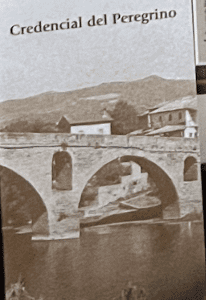
There’s a good reason this devout Seventh-Day Adventist woman felt uncomfortable when considering the Camino as spiritual travel. Protestantism formed almost directly in response to pilgrimages to see relics—and especially to the notion of indulgence from the church as sacred boon for the repentant sinner. Measuring how many miles I was biking and whether it fit the definition of a “real” Camino, attending a mass at the end of the trip, visiting the tomb of St. James—all of it was a bit medieval to me, and had me questioning why I was doing this as a spiritual journey.
Can (or should!?) a non-Catholic who is committed to salvation by faith and the priesthood of all believers (ideas at the heart of the Reformation movement) take on these medieval spiritual practices? Is it possibly appropriation? Simply tourism dressed up in devout clothes?
The truth is that Protestants have remained deeply concerned with the historical roots of their faith and have encouraged and benefitted from visiting sites from both Biblical texts and from early Christianity. While it was of course a metaphor, one of the early classics of English Protestantism was even titled Pilgrim’s Progress. As the centuries have gone on, many of us have also had spiritual benefit from visiting places where the Reformation high points occurred. Spiritual travel remains a powerful part of our lives, and even going to the places where Christian leaders lived can help connect us to our mothers and fathers in the faith. I’ve enjoyed seeing the houses lived in by my denomination’s 19th century leader Ellen White and touring the home of the influential writer C.S. Lewis.
Social Scientist Robbie Goh has called Protestant pilgrimages “Spiritual Mapping,” especially when they focus on Protestant leaders and a certain kind of Reformation hagiography. Good old regular tourism is definitely involved in all this, as it has always been for pilgrimage, including the medieval ones. Significantly of course, Protestants don’t ask their religious leaders to affirm the salvatory or spiritual boon when they complete their pilgrimage. There may be less tracking of whether one has done the pilgrimage properly—perhaps a bit more populism and democracy in how the travel is organized. However, the inclusion of worship, sacred texts, rituals and traditions around what to do at that site are just as much a part of Protestant sacred travel as they are for Catholics.
Apparently, the increasing popularity of the Camino (on bicycles, on foot, on horseback, etc) has caused a resurgence of pilgrimage activity throughout Europe. (What about other regions of the world? That remains to be seen.) The trappings of the Camino have become the quintessential way to do a pilgrimage—stamps, iconic symbols like the shell of the Camino, and inclusion of secular as well as religious travelers.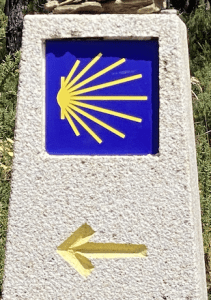
Throughout the 10 days of our trip, it was very easy to forget this was a pilgrimage and think of it as a well-marked hiking/biking path through beautiful country. And there was a constant barrage of items to buy to remind oneself of the trip and to take back as badges of our success. The shell is everywhere and when we finished the epic trip, there was no end to amount of shell-shaped/imprinted items that we wanted to take home with us. Crass materialism? Vain glory? Just another tourist trap?
It turns out that spiritual travel, or pilgrimage, can come with swag and still be a benefit to those who do it. In a world rife with capitalism, even trips with constant temptations to shop can still strengthen our faith and connect us to our fellow Christians. Pilgrimage is a value partly because it calls us away from our daily lives and asks us to submit ourselves to suffering and financial sacrifice during a season we have dedicated to concentrating on something within our faith tradition and history. It can teach us inspirational stories and cause us to develop trust and by putting us in a new place with strangers it allows us to expand our experience of the Providence of God. And because we are looking for it, we are more likely to see it.
Our group learned to pray hard when we were exhausted and worn out, or when we had lost track of each other on the path, or when we were worried about lost items or broken equipment. We practiced sharing with each other what God was doing in us. We learned to appreciate each other and took the time to hear each other’s stories regarding the challenges of our current lives that the Camino was taking us away from for a minute.
Now, lots of travel, including international Christian service trips, can do the same thing. But there’s something about traveling in land and to a place where others have gone for generations also seeking to hear and see God. And for that to be connected to historical events and people in our Christian history helps us learn more about ourselves and the ways the Spirit keeps unfolding across the centuries, for the way we can be spiritually surprised when we go to new lands to pray and walk (or bike!).
I didn’t have any “aha” moments on the Camino that changed my spiritual life forever. However, I did come back with a commitment to thinking more about pilgrimage close at hand, developing rituals around spiritual travel that value the land and traditions that are in my locale. Maybe my church could start a tradition of walking for the purpose of visiting a lesser-known site (like the original site of the Highlander Folk School which is in the mountains just a few miles from my home) and praying there and maybe lighting a candle or singing a song or developing other rituals around that. I think submitting myself to learning and visiting and praying around Christian history in my area can connect me in even greater ways to the richness of the Providence of God. It takes time out of my daily life, but the inconvenience is part of what makes it a pilgrimage. For any who are interested in thinking more about how pilgrimage could enrich their lives, whether close at hand or far away, or metaphorical or literal, I recommend starting with Pilgrimage as Spiritual Practice and To Be a Pilgrim.


